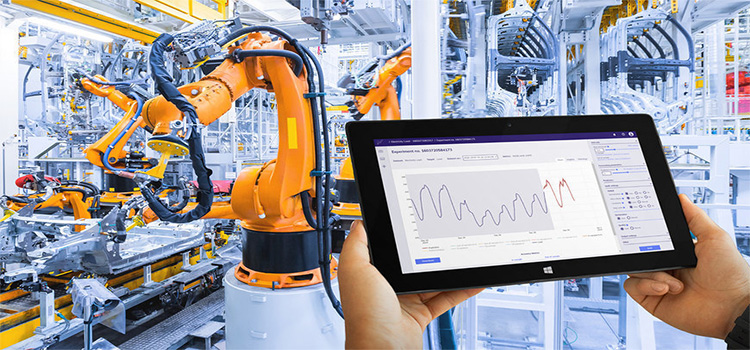
SLAM Robots Market by Type (Extended Kalman Filter SLAM, Graph-based SLAM, Fast SLAM, and Others), by Solution (Two-dimensional SLAM and Three-dimensional SLAM), by Application (Robotics, Unmanned Aerial Vehicle (UAV), Augmented Reality (AR)/Virtual Reality (VR), and Autonomous Vehicle), by End User Industry (Military, Agriculture & Forestry, Mining, Automotive, Manufacturing & Logistics, and Household Appliance, and Others) - Global Opportunity Analysis and Industry Forecast, 2023-2030
Market Definition
The global SLAM Robots Market size was valued at USD 0.29 billion in 2022 and is predicted to reach USD 5.79 billion by 2030 with a CAGR of 53.4% from 2023-2030. SLAM (simultaneous localization and mapping) is a mapping technology that allows robots and other autonomous vehicles to build a map while also localizing themselves on that map. They are used in a variety of outdoor, indoor, underwater, and aerial applications for self-driving and manually operated appliances, equipment, and vehicles.
For instance, SLAM robots are used in vacuum cleaners and lawn mowers, along with operations such as surveillance using Unmanned Aerial Vehicles (UAVs), underwater coral reef monitoring, underground mine exploration, and terrain mapping applications in space. In addition, SLAM robots aid in the mapping of environments using mapping features such as grid-based scans, two-dimensional mapping, and three-dimensional mapping.
Market Dynamics and Trends
Growing consumer demand in several industries such as food & beverage, logistics, and e-commerce has pushed to automate their production processes that requires the use of mobile robots equipped with SLAM technology to navigate safely across these facilities and perform their assigned tasks. For instance, in March, 2022, Locus Robotics launched two autonomous mobile robots (AMRs) equipped with SLAM called Locus Max and Locus Vector. They are capable of case-picking, pallet-picking and supports full range of movement even with larger and heavier payloads.
Moreover, increasing global demand for autonomous electric vehicles is propelling the growth of the SLAM robotics market owing to the environmental consciousness and the availability of affordable electric vehicles that features SLAM technology. It further provides safety features such as collision avoidance systems, lane departure warnings, and impact evasion frameworks due to surge in the number of road fatalities around the world.
Thus, automotive manufactures are integrating LiDAR SLAM technology into their autonomous vehicles to create a precise map of surroundings for a moving vehicle to safely navigate in a wide range of lighting and environmental conditions. For instance, in September 2022, Volvo cars launching its next generation electric SUV named EX90, which will feature LiDAR SLAM technology to scope the car’s surroundings. EX90 can detect pedestrians at up to 250 metres and small objects up to 120 metres ahead, at highway speeds. The LiDAR tech will be embedded in the roofline of the EX90 and will detect and assist the driver in different hazardous scenarios.
However, high implementation cost of SLAM robots, limited area size of EKF filter based SLAM, and requirement of central server in such technology, which limits a robot’s autonomy are the factors restraining the growth of SLAM robots’ market. On the contrary, introduction of industry 4.0 that uses technologies such as AI, cloud and IoT along with SLAM robots to increase connectivity and productivity of production or manufacturing facilities are expected to create ample opportunities for the market in the coming years.
Market Segmentations and Scope of the Study
The SLAM robots market report is segmented on the basis of type, solutions, application, end user industry and region. On the basis of type, the market is segmented into extended kalman filter SLAM, graph-based SLAM, fast SLAM, and others. Based on solutions, the market is divided into two-dimensional SLAM and three-dimensional SLAM. On the basis of application, the market is categorized into robotics, unmanned aerial vehicle (UAV), augmented reality (AR)/virtual reality (VR), and autonomous vehicle. Based on end user industry, the market classified into military, agriculture & forestry, mining, automotive, manufacturing & logistics, and household appliance, and others. Geographic breakdown and analysis of each of the previously mentioned segments include regions comprising North America, Europe, Asia-Pacific, and RoW.
Geographical Analysis
North America holds the dominant share of SLAM robots market, and is expected to continue its dominance during the forecast period. This is attributed to factors such as high expenditure of defense sector in this region that enables the military to use advance SLAM robots such as drones, security robots, reconnaissance robots to perform various tasks that can improve the safety and efficiency of military operations. For instance, in August 2022, U. S. military signed USD 8 million contract with AeroVironment, that covers the purchase, testing, and delivery of one JUMP 20 medium drone equipped with LiDAR SLAM technology.
Moreover, presence of key market players such as Amazon Robotics, Intel, Meta Platforms Inc., Intel Corporation, and Google LLC. further boost the market growth on the region. For instance, in June 2022, Amazon robotics announced an autonomous mobile robot called Proteus. Proteus is capable of moving autonomously through facilities using SLAM technology. Amazon aims initially deploy Proteus in the outbound GoCart handling areas in its fulfillment centers and sort centers to automate GoCart handling across these facilities, which will help reduce the need for people to manually move heavy objects, in turn increasing productivity and efficiency.
On the other hand, Asia-Pacific is expected to show a steady rise in the SLAM robots market owing to the high adoption of mobile robots for day-to-day services in corporate offices across the region. For instance, in June 2022, Samsung announced that the company is collaborating with Naver Cloud to launch an autonomous mobile robot called Rookie in South Korea. Rookie is equipped with SLAM technology that helps it to efficiently navigate in indoor surroundings and it will be utilized for delivery service in Naver headquarters in South Korea to deliver coffees and lunch boxes to Its employees.
Moreover, high adoption of drones in mining industries in countries such as Australia for collecting visual data of volatile and difficult areas such as deep/high terrains of mine, crests, highwalls, and inside stopes is driving the growth of the market in Asia Pacific. They are also utilized for aerial data capturing from blast sites, which reduces the risk of exposure on the ground to enhance safety and improve overall productivity. For instance, in July 2020, Emesent launched autonomy for beyond-line-of-sight underground UAV flight called AL2. AL2 is developed upon Emesent’s Hovermap simultaneous localization and mapping (SLAM) autonomous flight system, that will enable drones to fly beyond communications range and venture beyond line of sight into unmapped areas.
Competitive Landscape
Various market players operating in the SLAM robots industry includes KUKA AG, Omron Adept Technologies, Inc., Clearpath Robotics Inc., Mobile Industrial Robots A/S, SMP Robotics Systems Corp., Aethon Inc., Locus Robotics Corporation, Fetch Robotics, Inc., Amazon Robotics LLC., Flyablity and others. These market players are adopting strategies such as product launches and joint ventures across various regions to maintain their dominance in the global market.
For instance, in June 2022, Apple Inc. launched ARKit 6 in WWDC22 that uses SLAM technology and includes device motion tracking, advanced scene processing, camera scene capture, and display features that improve users' AR experiences.
Moreover, in May 2021, Intel collaborated with Semtech to develop advanced LiDAR for its SLAM technology. Under this collaboration Intel aims to leverage from Semtech's advanced laser drivers and programmable transimpedance amplifiers (TIAs), which will integrated into Intel's RealSense LiDAR Camera L515 enabling the company to produce a consumer LiDAR.
Key Benefits
-
The report provides quantitative analysis and estimations of the SLAM robots market from 2023 to 2030, which assists in identifying the prevailing market opportunities.
-
The study comprises a deep-dive analysis of the SLAM robots market including the current and future trends to depict prevalent investment pockets in the market.
-
Information related to key drivers, restraints, and opportunities and their impact on the SLAM robots market is provided in the report.
-
Competitive analysis of the players, along with their market share is provided in the report.
-
SWOT analysis and Porters Five Forces model is elaborated in the study.
-
Value chain analysis in the market study provides a clear picture of roles of stakeholders.
SLAM Robots Market Key Segments
By Type
-
Extended Kalman Filter SLAM
-
Graph-based SLAM
-
Fast SLAM
-
Others
By Solution
-
Two-dimensional SLAM
-
Three-dimensional SLAM
By Application
-
Robotics
-
Unmanned Aerial Vehicle (UAV)
-
Augmented Reality (AR)/Virtual Reality (VR)
-
Autonomous Vehicle
By End User Industry
-
Military
-
Agriculture & Forestry
-
Mining
-
Automotive
-
Manufacturing & Logistics
-
Household Appliance
-
Others
By Region
-
North America
-
The U.S.
-
Canada
-
Mexico
-
-
Europe
-
The UK
-
Germany
-
France
-
Italy
-
Spain
-
Denmark
-
Netherlands
-
Finland
-
Sweden
-
Norway
-
Russia
-
Rest of Europe
-
-
Asia-Pacific
-
China
-
Japan
-
India
-
South Korea
-
Australia
-
Indonesia
-
Singapore
-
Taiwan
-
Thailand
-
Rest of Asia-Pacific
-
-
RoW
-
Latin America
-
Middle East
-
Africa
-
Report Scope and Segmentation:
|
Parameters |
Details |
|
Market Size in 2022 |
USD 0.29 Billion |
|
Revenue Forecast in 2030 |
USD 5.79 Billion |
|
Growth Rate |
CAGR of 53.4% from 2023 to 2030 |
|
Analysis Period |
2022–2030 |
|
Base Year Considered |
2022 |
|
Forecast Period |
2023–2030 |
|
Market Size Estimation |
Billion (USD) |
|
Growth Factors |
Growing consumer demand in several industries such as food & beverage, logistics, and e-commerce. Increasing global demand for autonomous electric vehicles. |
|
Countries Covered |
28 |
|
Companies Profiled |
10 |
|
Market Share |
Available for 10 companies |
|
Customization Scope |
Free customization (equivalent to up to 80 working hours of analysts) after purchase. Addition or alteration to country, regional, and segment scope. |
|
Pricing and Purchase Options |
Avail customized purchase options to meet your exact research needs. |
Key Players
-
KUKA AG
-
Omron Adept Technologies, Inc.
-
Clearpath Robotics Inc.
-
Mobile Industrial Robots A/S
-
SMP Robotics Systems Corp.
-
Aethon Inc.
-
Locus Robotics Corporation
-
Fetch Robotics, Inc.
-
Amazon Robotics LLC.
-
Flyablity




 Speak to Our Analyst
Speak to Our Analyst


































